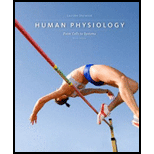
Human Physiology: From Cells to Systems (MindTap Course List)
9th Edition
ISBN: 9781285866932
Author: Lauralee Sherwood
Publisher: Cengage Learning
expand_more
expand_more
format_list_bulleted
Concept explainers
Question
Chapter 3, Problem 6RE
Summary Introduction
To match:
The means of membrane transport on the left with the direction of movement on the right.
Introduction:
Any substance that passes between cells and the enveloping extracellular fluid must possess the tendency to pass through the plasma membrane. If a component can pass through the membrane, the membrane is considered permeable for that component, however, in case if the component cannot pass, then the membrane is considered impermeable to it. The plasma membrane possesses the tendency of selective permeability, that is, it allows some of the particles to go through while inhibiting the others.
Expert Solution & Answer
Trending nowThis is a popular solution!

Students have asked these similar questions
What are biofertilizers and mention the significance
PCBs and River Otters: Otters in Washington State’s Green-Duwamish River have high levels of polychlorinated biphenyls (PCBs) in their livers. PCBs can bind to the estrogen receptors in animals and disrupt the endocrine system of these otters. The PCBs seem to increase the estrogen to androgen ratio, skewing the ratio toward too much estrogen.
How would increased estrogen affect the river otter population?
Based on your reading of the materials in this unit, what factors can affect fertility in humans?
Explain how each of the factors affecting human fertility that you described can disrupt the human endocrine system to affect reproduction.
Other than oil and alcohol, are there other liquids you could compare to water (that are liquid at room temperature)?
How is water unique compared to these other liquids?
What follow-up experiment would you like to do, and how would you relate it to your life?
Chapter 3 Solutions
Human Physiology: From Cells to Systems (MindTap Course List)
Ch. 3.1 - Draw how phospholipid molecules align themselves...Ch. 3.1 - Prob. 2CYUCh. 3.1 - Prob. 3CYUCh. 3.2 - Prob. 1CYUCh. 3.2 - Prob. 2CYUCh. 3.2 - Prob. 3CYUCh. 3.3 - Prob. 1CYUCh. 3.3 - Distinguish between passive and active forces that...Ch. 3.4 - List the means of unassisted membrane transport.Ch. 3.4 - Prob. 2CYU
Ch. 3.4 - Prob. 3CYUCh. 3.5 - Draw a graph comparing simple diffusion down a...Ch. 3.5 - Describe what causes the carrier to change shape...Ch. 3.5 - Distinguish between symport and antiport.Ch. 3.6 - Prob. 1CYUCh. 3.6 - Describe the relative contributions of k+ and Na+...Ch. 3.6 - Prob. 3CYUCh. 3 - The nonpolar tails of the phospholipid molecules...Ch. 3 - Prob. 2RECh. 3 - Prob. 3RECh. 3 - At resting membrane potential, there is a slight...Ch. 3 - Using the answer code on the right, indicate which...Ch. 3 - Prob. 6RECh. 3 - Prob. 7RECh. 3 - Prob. 1UCCh. 3 - Prob. 2UCCh. 3 - What two properties of a particle influence...Ch. 3 - Prob. 4UCCh. 3 - Prob. 5UCCh. 3 - Prob. 6UCCh. 3 - Describe the contribution of each of the following...Ch. 3 - Using the Nernst equation, calculate the...Ch. 3 - One of the important uses of the Nernst equation...Ch. 3 - Using the Goldman-Hodgkin-Katz equation, determine...Ch. 3 - When William H. was helping victims after a...Ch. 3 - Which of the following methods of transport is...Ch. 3 - Assume that a membrane permeable to Na+ but not to...Ch. 3 - A solution may have the same osmolarity as normal...Ch. 3 - Prob. 4TAHLCh. 3 - Prob. 5TAHL
Knowledge Booster
Learn more about
Need a deep-dive on the concept behind this application? Look no further. Learn more about this topic, biology and related others by exploring similar questions and additional content below.Similar questions
- Selection of Traits What adaptations do scavengers have for locating and feeding on prey? What adaptations do predators have for capturing and consuming prey?arrow_forwardCompetition Between Species What natural processes limit populations from growing too large? What are some resources organisms can compete over in their natural habitat?arrow_forwardSpecies Interactions Explain how predators, prey and scavengers interact. Explain whether predators and scavengers are necessary or beneficial for an ecosystem.arrow_forward
- magine that you are conducting research on fruit type and seed dispersal. You submitted a paper to a peer-reviewed journal that addresses the factors that impact fruit type and seed dispersal mechanisms in plants of Central America. The editor of the journal communicates that your paper may be published if you make ‘minor revisions’ to the document. Describe two characteristics that you would expect in seeds that are dispersed by the wind. Contrast this with what you would expect for seeds that are gathered, buried or eaten by animals, and explain why they are different. (Editor’s note: Providing this information in your discussion will help readers to consider the significance of the research).arrow_forwardWhat is the difference between Uniporters, Symporters and Antiporters? Which of these are examples of active transport?arrow_forwardWhat are coupled transporters?arrow_forward
- How do histamine and prostaglandins help in the mobilization of leukocytes to an injury site? What are chemotactic factors? How do they affect inflammation process?arrow_forwardCompare and contrast neutrophils and macrophages. Describe two ways they are different and two ways they are similar.arrow_forwardDescribe the effects of three cytokines (not involved in the initial inflammation response). What cells release them?arrow_forward
arrow_back_ios
SEE MORE QUESTIONS
arrow_forward_ios
Recommended textbooks for you
 Human Physiology: From Cells to Systems (MindTap ...BiologyISBN:9781285866932Author:Lauralee SherwoodPublisher:Cengage Learning
Human Physiology: From Cells to Systems (MindTap ...BiologyISBN:9781285866932Author:Lauralee SherwoodPublisher:Cengage Learning

Human Physiology: From Cells to Systems (MindTap ...
Biology
ISBN:9781285866932
Author:Lauralee Sherwood
Publisher:Cengage Learning
The Cell Membrane; Author: The Organic Chemistry Tutor;https://www.youtube.com/watch?v=AsffT7XIXbA;License: Standard youtube license